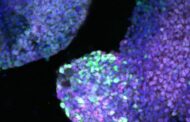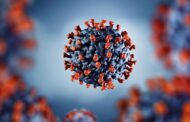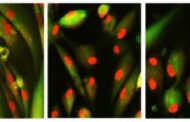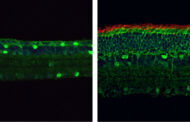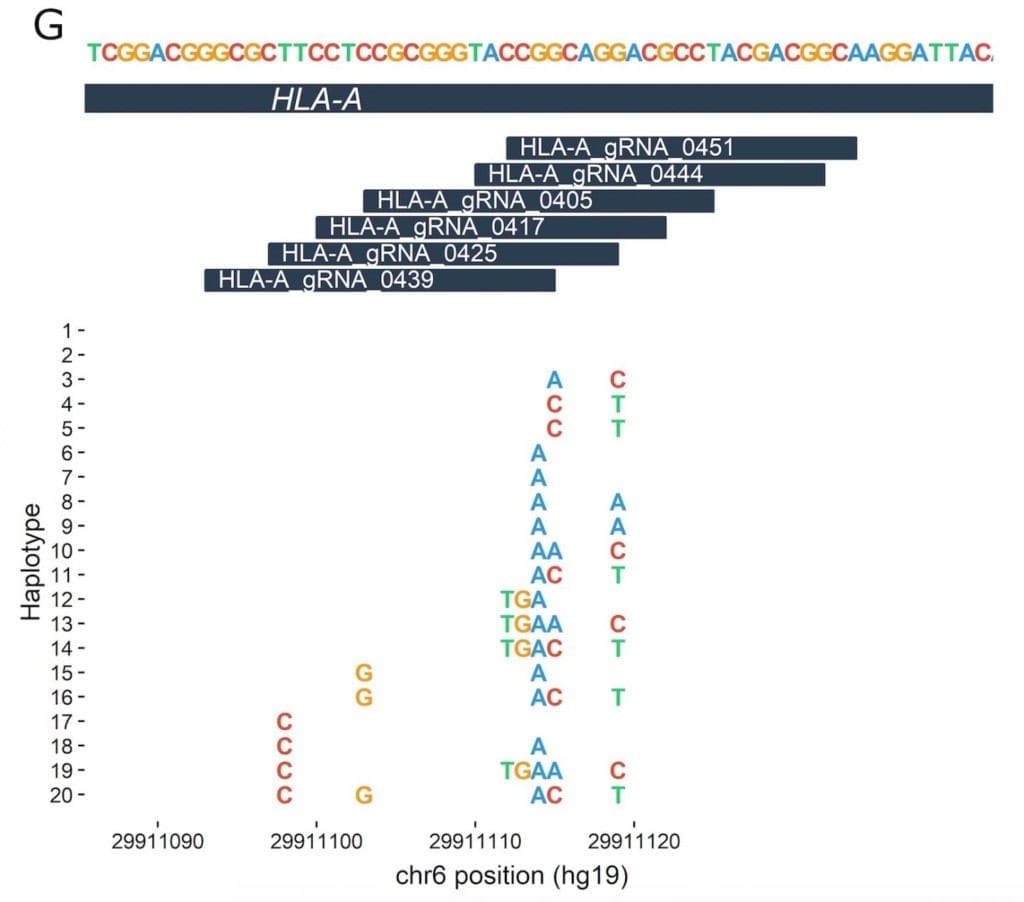
The top of this diagram shows a 30-base-pair region of a single genetic locus (HLA-A) that is involved in the immune response and could potentially be targeted with gene editing. The six smaller bars below it represent different guide RNAs that are designed to bind to different parts of that HLA-A locus. On the Y (vertical) axis are haplotypes with highlighted DNA variations identified from different individuals. They are aligned according to their positions in the genetic sequence (represented horizontally on the X axis).
CREDIT
Lessard S; et al. PNAS Early Edition, week of Dec. 11, 2017.
Patients’ individual genomes may affect efficacy, safety of gene editing
Gene editing has begun to be tested in clinical trials, using CRISPR-Cas9 and other technologies to directly edit DNA inside people’s cells, and multiple trials are recruiting or in the planning stages. A new study led by Boston Children’s Hospital and the University of Montreal raises a note of caution, finding that person-to-person genetic differences may undercut the efficacy of the gene editing process or, in more rare cases, cause a potentially dangerous “off target” effect.
The study adds to evidence that gene editing may need to be adapted to each patient’s genome, to ensure there aren’t variants in DNA sequence in or near the gene being targeted that would throw off the technology. Findings appear this week in the Proceedings of the National Academy of Sciences Early Edition (December 11-15).
“Humans vary in their DNA sequences, and what is taken as the ‘normal’ DNA sequence for reference cannot account for all these differences,” says Stuart Orkin, MD, of Dana-Farber Boston Children’s Cancer and Blood Disorders Center and co-corresponding author on the study with Matthew Canver, an MD-PhD student at Harvard Medical School. “We recommend that common variation be taken into account in designing targeting systems for therapeutic editing, to maximize efficacy and minimize potential safety concerns.”
The study analyzed 7,444 previously published whole-genome sequences. Based on a list of about 30 disease-related DNA targets that researchers are interested in altering through gene editing, the researchers made a second list of nearly 3,000 guide RNAs (gRNAs). These are bits of genetic code that have been developed to direct CRISPR-Cas9 enzymes to the right editing location on or adjacent to the target, like the address on an envelope.
The team, led by Orkin, Canver and Samuel Lessard of the University of Montreal, then looked to see whether any of the 7,444 individuals carried DNA sequence variants (“letter changes” or insertions/deletions) in the areas the gRNAs are looking for.
“If there are genetic differences at the site that CRISPR reagents are targeting for therapy, you are at risk for decreased efficacy or treatment failure,” explains Canver, who conceived and led the study in Orkin’s Boston Children’s Hospital lab. “A difference in just a single base pair can cause a decrease in binding efficiency due to a mismatch with the guide RNA. Overall, this can cause a reduction in treatment efficacy.”
The team found that such occurrences in the genome are not uncommon; about 50 percent of the analyzed gRNAs had the potential to be affected by variants at their target sites. In a few cases, the team found genetic variants that cause DNA sequences in the genome to more closely match a gRNA that could potentially draw it to the wrong place — resulting in an edit of a gene or other DNA region that’s not meant to be targeted.
“In rare cases, there was the potential to create very potent ‘off-target’ sites – where CRISPR reagents could bind and cut where they’re not intended to,” says Canver. “If an off-target effect happens to be in, say, a tumor suppressor gene, that would be a big concern.”
Although the study looked at CRISPR-Cas9 gene editing, the researchers believe their findings extend to other gene-editing tools such as zinc-finger nucleases (ZFN) and TAL effector nucleases.
“The unifying theme is that all these technologies rely on identifying stretches of DNA bases very specifically,” says Canver. “So, a variant that affects the target sequence could reduce guide RNA binding. Variants can also lead to binding at new sites that could potentially cause harm. As these gene-editing therapies continue to develop and start to approach the clinic, it’s important to make sure each therapy is going to be tailored to the patient that’s going to be treated.”
Learn more: Patients’ individual genomes may affect efficacy, safety of gene editing
The Latest on: Gene editing
[google_news title=”” keyword=”gene editing” num_posts=”10″ blurb_length=”0″ show_thumb=”left”]
- Research identifies gene that controls production of flowers and fruits in pea plantson April 18, 2024 at 10:46 pm
Reserachers have found that a gene called FUL controls the duration of the reproductive phase in crops such as peas.
- Poseida Therapeutics Announces Strong Lineup of Presentations at the American Society of Gene and Cell Therapy 27th Annual Meetingon April 18, 2024 at 5:00 am
Poseida Therapeutics, Inc. (Nasdaq: PSTX), a clinical-stage cell therapy and genetic medicines company advancing a new class of treatments for patients with cancer and rare diseases, today announced ...
- Gene editing crops to be colourful could aid weeding, say scientistson April 17, 2024 at 12:53 pm
Creating visually distinctive plants likely to become important as more weed-like crops are grown for food ...
- Precision BioSciences: Strategic Independence and Promising Gene Editing Pipeline Fuel Buy Ratingon April 17, 2024 at 11:16 am
H.C. Wainwright analyst Patrick Trucchio reiterated a Buy rating on Precision BioSciences (DTIL – Research Report) today and set a price ...
- Eli Lilly's Prevail Therapeutics Ends Gene-Editing Collaboration With Precision BioScienceson April 17, 2024 at 10:28 am
Precision BioSciences will regain control of three preclinical in vivo gene therapy candidates, including one for Duchenne muscular dystrophy.
- Turning plants blue with gene editing could make robot weeding easieron April 17, 2024 at 8:00 am
Weeding robots can sometimes struggle to tell weeds from crops, but genetically modifying the plants we want to keep to make them brightly coloured would make the job easier, suggest a group of resear ...
- Buy Rating Affirmed for Precision BioSciences Amid Strong Gene Editing Prospects and Upcoming Milestoneson April 17, 2024 at 6:05 am
In a report released today, Soumit Roy from JonesTrading maintained a Buy rating on Precision BioSciences (DTIL – Research Report), with ...
- Lilly's Prevail walks away from gene editing collab with Precisionon April 17, 2024 at 5:48 am
Nine months after Eli Lilly’s Prevail Therapeutics reduced the biobucks value of a gene editing deal with Precision Biosciences, the Big Pharma subsidiary has ...
- A Bold Gene-Editing Solution Began Testing—Then Hit the Strangest Twiston April 15, 2024 at 5:00 am
The Boston-based biotech firm Verve Therapeutics recently had to pause a clinical trial after a participating patient developed an unforeseen side effect to the gene-editing serum. The company says ...
- Nvelop launches to deliver gene-editing cargoon April 11, 2024 at 1:25 pm
Nvelop Therapeutics has launched to improve gene therapy delivery. The company was first founded in 2022 with $100 million in funding from investors on the basis of independently developed platforms ...
via Google News and Bing News



